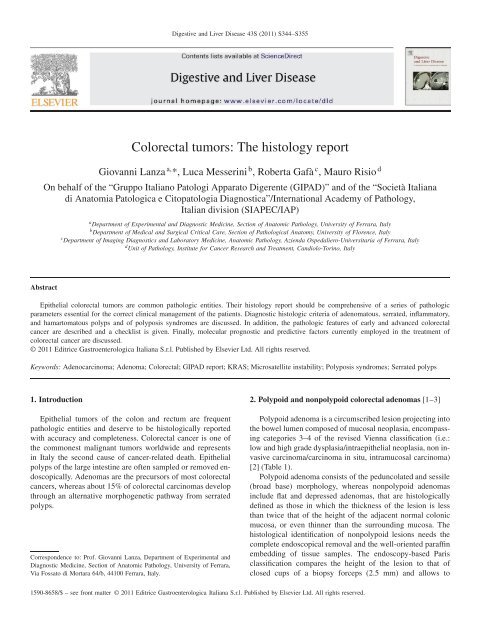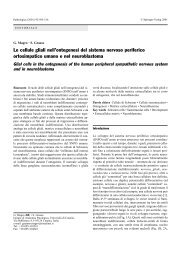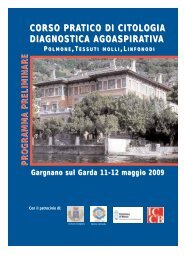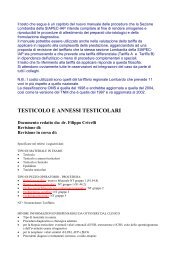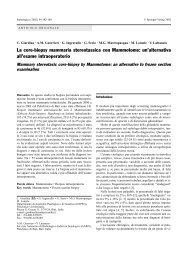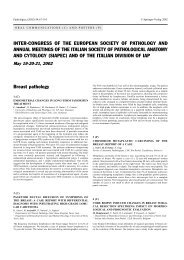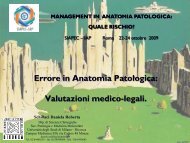Colorectal tumors: The histology report - Siapec - IAP
Colorectal tumors: The histology report - Siapec - IAP
Colorectal tumors: The histology report - Siapec - IAP
Create successful ePaper yourself
Turn your PDF publications into a flip-book with our unique Google optimized e-Paper software.
S346G. Lanza et al. / Digestive and Liver Disease 43S (2011) S344–S3553. Cancerized adenoma, malignant polyp (pT1 colorectalcancer) [3]Neoplastic invasion into the submucosa through the muscularismucosae (Category 5 in accordance with the revisedVienna Classification) is diagnostic of cancerized adenoma[Diagnostic strength: Level 3]. Colonic intramucosal carcinomabehaves like a benign adenoma and for this reasonpolyps harbouring “in situ” or “intramucosal” cancer (Categories4.2 and 4.4, respectively) are not generally regardedas “malignant” polyps and classified as high grade dysplasia,high grade intraepithelial neoplasia or mucosal highgrade neoplasia (Table 1). Cancerized adenomas representthe earliest form of clinically relevant colon cancer in mostpatients. Invasion of the submucosa, in fact, opens the way tometastasis via the haematogenous and lymphatic routes, andthe choice between surveillance and major surgery when anendoscopically removed polyp is found to be an ACIC willhinge on its metastatic potential, taking into account that postoperative mortality (within 30 days) ranges from 0.6 to 4.4%in T1 cancers. At present, histopathologic parameters alonedetermine whether a high (35%) or low (7%) risk of nodalmetastases exists [5–8]. Histologic risk factors – namely positiveresection margin, poor differentiation of cancer, vascularinvasion and tumor budding – do not only predict lymph nodedisease rate but also distant metastasis and mortality rates.3.1. Carcinoma grading [Diagnostic strength: Level 3]Histologic grade should be in accordance with the systemused in advanced colorectal cancer and distinguish well/moderately (low grade) from poorly differentiated (highgrade) <strong>tumors</strong>. It is based on the worst area, independentlyfrom its extension. An anaplastic component (even in the formof small, single or scattered foci) should be identified, as itsoccurrence strongly correlates with the risk of lymph nodemetastases. Signet ring cell carcinoma should be graded aspoorly differentiated. Tumor budding at the front of invasionshould not influence carcinoma grading and should be scoredseparately (see below).3.2. Vascular invasion [Diagnostic strength: Level 2]Lymphatic invasion requires the presence of cancer cellswithin endothelial-lined channels or spaces, distinguishingsuch features from retraction artefacts. Venous invasion isdefined as tumor emboli within endothelial-lined channelssurrounded by a smooth muscle wall. Uncertainty in theassessment (presence vs absence) of neoplastic vascularinvasion, even after the examination of serial and deeperroutinely H&E stained sections, should be <strong>report</strong>ed. Evidenceis lacking for the additional use of immunohistochemistry indetecting vascular invasion.3.3. Margin involvement [Diagnostic strength: Level 3]A negative deep (basal) margin is <strong>report</strong>ed in the absenceof cancer within the diathermy and one high-power fieldfrom diathermy, or more than 1 mm from the actual marginof resection <strong>The</strong> presence of adenomatous tissue in thelateral mucosal resection margin should also be independently<strong>report</strong>ed as an indication for further endoscopic treatment.3.4. Tumor budding [Diagnostic strength: Level 2]An isolated single cancer cell and a cluster composedof fewer than 5 cancer cells are defined as “budding” foci.Although several studies have shown that tumor buddingis independently associated with lymph node and distantmetastasis as well as shorter disease free and overall survivalin colorectal cancer, there is no consensus with regard to theassessment methods and cut-off values.Due to the usually small dimension of the submucosal invasivefront in cancerized adenomas, tumor budding should beassessed in the area where the highest activity is identified onH&E, reserving immunohistochemistry for the better assessmentof this feature. Awaiting the results from reproducibilitystudies, a quantitative, two-grade system (low vs. high grade)is advisable, counting tumor buds (< or ≥10) within a 0.385mm 2 area using a ×25 lens.3.5. Microstaging [Diagnostic strength: Level 2]<strong>The</strong> level of submucosal invasion, assessed as Haggitt levelsI–IV in peduncolated polyps and as sm1–3 Kikuchi levelsin sessile polyps, is important in predicting the outcome ofcancerized adenomas. On the other hand, cancerized adenomaswith slight submucosal invasion to the depth of 200–300micrometers are very unlikely to have metastatic lymph nodesand the quantitative measurements of both depth (< or >2000micrometers) and width (< or >4000 micrometers) of thecancerous submucosal invasion are strongly indicative of thenodal involvement and worthy <strong>report</strong>ing. In this setting therough estimate of the ratio of adenomatous to carcinomatoustissue is meaningful, indicating the prevalence of the potentiallymetastatic cancerous tissue within the polyp, the risk oflymph node metastasis being likely high (even in the absenceof other risk parameters) in pT1 polypoid adenocarcinoma,consisting entirely of cancer without adenoma.4. Serrated polyps [3,9,10]Epithelial serration, namely the saw-toothed outline derivedfrom infolded epithelial tufts in the crypt and inthe luminal surface can be found in several histotypes ofcolorectal polyps. Transient serration associated with hyperproliferationcan be seen in inflammatory polyps, above allof myoglandular type. Steady serration is displayed in thecommon hyperplastic polyps of the large bowel and, coupledwith focal or diffuse epithelial neoplastic changes, in serrated
G. Lanza et al. / Digestive and Liver Disease 43S (2011) S344–S355 S347adenomas and mixed polyps. Furthermore, cell maturationand differentiation are altered in serrated epithelium, particularlyin the mucus-producing process, so that abnormal gobletcell, microvesicular, and mucus-poor cell components can befound allowing the identification of different cytotypes ofserrated polyps: these, however, seem unrelated to differentrisks of tumor progression.4.1. Hyperplastic (metaplastic) polyps [Diagnostic strength:Level 3]Epithelial serration together with minimal architecturalchanges, and without cytological atypia are the diagnosticfeatures of hyperplastic polyps of the large bowel. <strong>The</strong>y aresmall-sized (0.2–0.5 cm) mucosal bumps of the sigmoid colonand rectum, consisting of straight, parallel, slightly elongatedcrypts lined by serrated epithelium in the intermediate andupper third, and by undifferentiated cells in the lower third.<strong>The</strong> nuclei are round or oval and located at the base with littleor no stratification.4.2. Sessile serrated adenomas (SSA)/sessile serrated polyps[Diagnostic strength: Level 2]SSA are mainly right-sited, large-sized (>1 cm) sessileserrated lesions displaying patchy or diffuse distorsions oftissue organization: branching of crypts, serration of foveolarcell phenotype at the base of the crypt, dilatation at the baseof the crypt, horizontal crypt growth [11]. Most findings areonly suggestive for SSA, and are localized in the deepersectors of the mucosa and require well-oriented samples foridentification. Subtle nuclear changes, when present, are focaland include small prominent nucleoli, open chromatin, andirregular contours. Frankly dysplastic nuclear abnormalities,indicative of the initial transition toward traditional serratedadenomas should be <strong>report</strong>ed, in terms of extension andneoplasia grade, in order to manage patient surveillance.Intermingling and/or intermediate features of SSA and hyperplasticpolyps can often be seen in the same histolgicalsection, impairing diagnostic reproducibility. <strong>The</strong> term “sessileserrated polyp” has therefore been suggested for equivocallesions and even as a synonym of SSA, considering the improperuse of “adenoma” for lesions lacking true neoplasticchanges.4.3. Traditional serrated adenomas (TSA) [Diagnosticstrength: Level 2]Nuclear (elongated, hyperchromatic, stratified nuclei) andcytological frankly dysplastic features are seen within theserrated epithelium, besides architectural changes and are diagnosticfor TSA [12]. Rapid and protuberant growth parallelsnuclear dysplasia and, grossly, TSA can be indistinguishablefrom villous or tubulovillous colorectal adenomas.4.4. Mixed polyps [Diagnostic strength: Level 2]In these polyps one or more serrated components (hyperplastic,SSA, TSA) are associated and/or intermingled withclassical adenomatous tissue (tubular, tubulovillous and villous).Extension and grading of neoplastic sectors should beexhaustively described in the diagnosis, in order to supportclinical decision making.5. Inflammatory polyps [13]Inflammatory polyps are defined as mucosal elevationsresulting from an inflammatory process. <strong>The</strong>y may occur inpatients with inflammatory bowel disease (IBD), as well as inpatients with other forms of colitis, such as infectious colitis,ischemic colitis, or diverticulitis. <strong>The</strong>y may be also inducedby a mucosal trauma due to an inappropriate peristalsis andin such cases are defined as mucosal prolapse-related inflammatorypolyps. Different entities such as inflammatory cappolyp, colitis cistica profunda and inflammatory myoglandularpolyp are considered to belong to the mucosal prolapsesyndrome. Inflammatory polyps do not show an increased riskof neoplastic transformation.Inflammatory polyps may be sessile or pedunculated, andtheir gross appearance varies from rounded lesions to fingerlikeprojections (filiform polyps, usually associated with IBD).<strong>The</strong>y may be single or multiple and their size generally rangesfrom few mm to 2 cm; sometimes, they may be extremelylarge (“giant” inflammatory polyps) and can cause intestinalobstruction.5.1. Histological features [Diagnostic strength: Level 3]<strong>The</strong> lamina propria shows an intense inflammatory cellinfiltrate and contains dilated and branched colonic crypts;neutrophilic cryptitis and crypt abscess may be prominent.<strong>The</strong> colonic surface epithelium and the colonic crypts mayshow both epithelial damage and regeneration. Intense vascularcongestion and hemorrhage may also be present. Mucosalprolapse-related inflammatory polyps show additional histologicalfeatures such as thickening and vertical extension ofthe muscularis mucosae toward the lamina propria.5.2. Differential diagnosis [Diagnostic strength: Level 2]<strong>The</strong> differential diagnosis between reactive epithelialchanges and epithelial dysplasia or neoplasia is the mainpotential pitfall that can occur in evaluating inflammatorypolyps. <strong>The</strong> regenerating epithelium usually shows maturationtoward the surface while dysplastic or neoplastic epitheliumdo not show surface maturation. Moreover, the presence of aninflammatory background should be carefully considered toavoid an overdiagnosis of dysplasia or neoplasia, particularlyin patients with IBD.Inflammatory polyps may contain bizarre stromal cells,that may be mistaken for a sarcoma (“pseudosarcomatous”
G. Lanza et al. / Digestive and Liver Disease 43S (2011) S344–S355 S349present. AFAP patients have a high risk of colorectal cancer.<strong>The</strong>se patients develop colorectal cancer 10 years earlier thanindividuals with sporadic colorectal cancer, but 15–20 yearslater than patients with classical FAP.MUTYH-associated adenomatous polyposis (MAP) [19]. Multipleadenomas can also occur in a subset of APC mutationnegativepatients. <strong>The</strong>se patients harbor germline mutationsin the repair gene MUTYH (MYH). <strong>The</strong> number of adenomasranges from 15 to more than 100. <strong>The</strong>se patientspresent a very high risk of developing colorectal cancer.Furthermore, the incidence of extra-colonic <strong>tumors</strong>, especiallyduodenal cancer, is higher than that of the general population.[Diagnostic strength: Level 3]8. Hyperplastic polyposis (HP) [20]<strong>The</strong> following criteria have been proposed to diagnose HP:1) at least five histologically diagnosed hyperplastic polypsproximal to the sigmoid colon of which two are greater than10 mm in diameter, or 2) any number of hyperplastic polypsoccurring proximal to the sigmoid colon in an individualwho has a first degree relative with HP, or 3) more than 30hyperplastic polyps of any size, but distributed throughout thecolon. [Diagnostic strength: Level 2]Individuals with HP develop colorectal cancer on a backgroundof multiple polyps that are mainly hyperplastic polyps.However, SSAs, TSAs and mixed polyps can also be foundin these patients; therefore it the suggestion is to consider alltypes of serrated polyps in diagnosing HP.9. Surgically resected colorectal cancerCareful pathologic <strong>report</strong>ing of colorectal cancer resectionspecimens is of paramount importance to determine theprognosis and to plan the treatment of individual patients.In addition, pathologists have an increasing role in theidentification of hereditary <strong>tumors</strong> and in prediction oftumor response to specific type of therapy. <strong>The</strong>re is clearevidence that the use of checklists improves the standard ofcolorectal cancer <strong>report</strong>ing and therefore their use is stronglyrecommended (Table 2). Pathologic parameters that needto be absolutely <strong>report</strong>ed on the basis of their prognosticvalue or that are required for therapy will be discussed. Inaddition, molecular prognostic and predictive factors recentlyintroduced in the clinical setting will be examined.9.1. Histologic type [1,21] [Diagnostic strength: Level 2]Histologic type should be evaluated according to the WHOclassification as follows [1].• Adenocarcinoma• Mucinous adenocarcinoma• Signet-ring cell carcinoma• Small cell carcinoma• Squamous cell carcinoma• Adenosquamous carcinoma• Medullary carcinoma• Undifferentiated carcinomaMost colorectal carcinomas (nearly 85%) are usual adenocarcinomas,and 10 to 15% are classified as mucinousadenocarcinomas (mucinous component >50%). <strong>The</strong> othertumor types are rare. Tumor typing does not have majorprognostic relevance, but signet-ring cell carcinoma and smallcell carcinoma have been demonstrated to have adverse prognosticsignificance independent of stage. Notwithstanding,the various subtypes of colorectal cancer are characterizedby different genetic alterations and probably more detailedprognostic information will be obtained in the future by anintegrated histologic and molecular classification [22].With respect to usual adenocarcinomas, mucinous <strong>tumors</strong>have a greater tendency to develop peritoneal metastases, toinvade adjacent organs and to show extensive lymph nodeinvolvement [21]. Mucinous carcinomas are evenly distributedin the right and left colon and more frequently than commonadenocarcinomas harbour defects in the DNA mismatch repair(MMR) system [23]. Mucinous adenocarcinomas differ fromcommon adenocarcinomas also on the basis of other molecularfeatures, such as higher frequency of CIMP phenotypeand rare p53 mutations, suggesting that these <strong>tumors</strong> reallyrepresent a distinct pathologic entity [22]. A less favourableclinical outcome for patients with mucinous cancers has beendemonstrated in many studies but not in others and theprognostic significance of the mucinous phenotype remains atpresent undetermined. In addition, the prognosis of mucinouscarcinomas with microsatellite instability (MSI) has been <strong>report</strong>edto be better than that of microsatellite stable mucinouscarcinomas.Signet-ring cell carcinoma is composed of at least 50%signet-ring cells. It represents less than 1% of all colorectalcarcinomas and occurs more frequently in individuals youngerthan 50 years of age and in patients with ulcerative colitis.Histologically, colorectal signet-ring cell carcinomas differfrom gastric ones for the common presence of abundantextracellular mucin and infrequent diffuse tissue infiltration.Signet-ring cell carcinomas are often at an advanced stageat diagnosis and are associated with a worse outcomethan common adenocarcinomas. Peritoneal carcinomatosisdevelops in the majority of patients who die of the disease.About 30% of signet-ring cell carcinomas display defect ofMMR function; however, MSI status does not appear to be asignificant predictor of survival in this tumor type.Small cell carcinomas are histologically identical to thosearising in the lungs. <strong>The</strong>y often appear to develop within anadenoma and usually express neuroendocrine markers. Partof the cases show a distinct adenocarcinomatous component.Most patients have distant metastases at diagnosis and theprognosis is very poor. Large cell poorly differentiatedneuroendocrine carcinomas may also occur in the colorectumand their clinical behaviour is similar to that of small cellcarcinomas.Medullary carcinomas are generally described as <strong>tumors</strong>
S350G. Lanza et al. / Digestive and Liver Disease 43S (2011) S344–S355Table 2Surgically resected specimens of colorectal cancer – ChecklistTumor siteCecumAscending colonHepatic flexureTransverse colonSplenic flexureDescending colonSigmoid colonRectosigmoid junctionRectumTumor sizeMaximum tumor diameter:Histologic typeAdenocarcinomaMucinous adenocarcinomaSignet-ring cell carcinomaSmall cell carcinomaSquamous cell carcinomaAdenosquamous carcinomaMedullary carcinomaUndifferentiated carcinomaOther (specify):cmGrade of differentiationLow grade (well or moderately differentiated)High grade (poorly differentiated or undifferentiated)High grade component (%):Depth of tumor invasionNo evidence of primary tumorTumor invades submucosa (pT1)Tumor invades muscularis propria (pT2)Tumor invades through the muscularis propria into the subserosal adiposetissue or the nonperitonealized pericolic or perirectal soft tissues (pT3)Tumor penetrates to the surface of the visceral peritoneum (serosa)(pT4a)Tumor directly invades other organs or structures(specify:) (pT4b)Tumor penetrates to the surface of the visceral peritoneum (serosa) anddirectly invades other organs or structures(specify:) (pT4b)Margins of resectionProximal/distal marginCannot be assessedInvasive carcinoma presentInvasive carcinoma absentDistance of invasive carcinoma from closest margin: mmCircumferential (radial) marginNot applicableCannot be assessedInvasive carcinoma presentInvasive carcinoma absentDistance of invasive carcinoma from non-peritonealised margin:Regional lymph nodesNumber examined:Number involved:Tumor depositsNot identifiedPresent (number: )Response to neoadjuvant therapyNot applicable (no prior treatment)Complete regressionMinimal residual tumorNo marked regressionmmTable 2 (continued)Extramural venous invasionNot identifiedPresentPathologic staging (pTNM)TNM descriptors (required only if applicable)m (multiple primary <strong>tumors</strong>)r (recurrent)y (posttreatment)Primary tumor (pT)pTX: Cannot be assessedpT0: No evidence of primary tumorpTis: Carcinoma in situ, intraepithelial or invasion of lamina propriapT1: Tumor invades submucosapT2: Tumor invades muscularis propriapT3: Tumor invades through the muscularis propria into pericolorectaltissuespT4a: Tumor penetrates the visceral peritoneumpT4b: Tumor directly invades other organs or structuresRegional lymph nodes (pN)pNX: Cannot be assessedpN0: No regional lymph node metastasispN1a: Metastasis in 1 regional lymph nodepN1b: Metastasis in 2 to 3 regional lymph nodespN1c: Tumor deposit(s) in the subserosa, or nonperitonealized pericolicor perirectal tissues without regional lymph node metastasispN2a: Metastasis in 4 to 6 regional lymph nodespN2b: Metastasis in 7 or more regional lymph nodesDistant metastasis (pM)Not applicablepM1: Distant metastasisSpecify site(s):pM1a: Metastasis to single organ or site (e.g., liver, lung, ovary,nonregional lymph node)pM1b: Metastasis to more than one organ/site or to the peritoneumAdditional pathologic findingsNone identifiedDiverticular disease, ulcerative colitis, Crohn’s disease, familialadenomatous polyposis, other forms of polyposis, synchronouscarcinoma(s) (complete a separate form for each cancer), etc.Specify:Polyps present (specify type and number):Comment(s):characterized by solid growth pattern and marked intratumoraland peritumoral lymphocytic infiltration, and composed bycells with vesicular nuclei, prominent nucleoli, and abundanteosinophilic cytoplasm [1,24]. Tumor cells form sheets ormay have an organoid or trabecular architecture; focal mucinproduction or glandular differentiation are often present.In our experience, medullary carcinomas often display aclearly evident glandular and/or mucinous component andare generally formed by quite uniform cells with mild ormoderate nuclear atypia and variable amount of cytoplasm[25]. Moreover, intense intratumoral and peritumoral lymphocyticinfiltration is not always present. At the molecularlevel, the great majority of medullary carcinomas show MSI,which probably explains their better prognosis with respect tocommon poorly differentiated adenocarcinomas [25].Undifferentiated carcinomas are <strong>tumors</strong> lacking morphologicalevidence of differentiation beyond that of an epithelialtumor [1]. Some authors include in this category <strong>tumors</strong>
G. Lanza et al. / Digestive and Liver Disease 43S (2011) S344–S355 S351showing a minimal component of gland formation (
S352G. Lanza et al. / Digestive and Liver Disease 43S (2011) S344–S355the radial margin is the most critical factor in predictinglocal recurrence in rectal cancer and is also associated withan increased risk of death from the disease [33]. <strong>The</strong> circumferentialmargin is considered positive if the tumor islocated 1 mm or less from the nonperitonealized surface.This assessment includes tumor within veins, lymphatics orlymph nodes and tumor deposits, as well as direct tumorextension. However, if circumferential margin involvementis based only on intranodal tumor, this should be stated. Inrectal cancer, the distance of the tumor from the radial marginshould be always <strong>report</strong>ed. <strong>The</strong> circumferential margin shouldbe also assessed in colonic segments incompletely encasedby peritoneum (e.g., cecum, ascending colon, and descendingcolon). <strong>The</strong> clinical relevance of pathologic examination ofthe surgical mesocolic plane of dissection has been recentlyrecognized [34].9.5. Regional lymph nodes [28,29] [Diagnostic strength:Level 3]<strong>The</strong> number of metastatic lymph nodes and the totalnumber of lymph nodes examined must always be <strong>report</strong>ed.Regional lymph node status should be assessed according tothe new TNM classification [28,29], as follows.pN0pN1pN2No regional lymph node metastasisMetastasis in 1–3 regional lymph nodespN1a Metastasis in 1 regional lymph nodepN1b Metastasis in 2–3 regional lymph nodespN1c Tumor deposit(s), i.e., satellites, in the subserosa,or in non-peritonealized pericolic orperirectal soft tissue without regional lymphnode metastasisMetastasis in 4 or more regional lymph nodespN2a Metastasis in 4–6 regional lymph nodespN2b Metastasis in 7 or more regional lymph nodesWith respect to the previous edition a subdivision of pN1and pN2 categories has been introduced, reflecting differencesin clinical outcome observed within each category on thebasis of the number of affected lymph nodes [31,32].Histological examination of a regional lymphadenectomyspecimen ordinarily includes 12 or more lymph nodes. Ifthe lymph nodes are negative, but the number ordinarilyexamined is not met, the tumor will be classified as pN0. Allmacroscopically evident lymph nodes in the surgical specimenshould be dissected and examined histologically. Many factorsinfluence lymph node recovery and evaluation, such as extentof surgical resection, quality of pathologic examination,patient factors, and tumor characteristics [35,36]. <strong>The</strong> meannumber of nodes detected in a series of dissections is nowconsidered to be indicative of colon cancer quality care [37]and should be comprised between 12 and 15 [24]. As nodalmetastases in colorectal cancer are often found in small lymphnodes (
G. Lanza et al. / Digestive and Liver Disease 43S (2011) S344–S355 S353for grading tumor regression have been proposed and thereis no general consensus on the histological classificationof this parameter. However, 3-tiered grading systems havebeen generally recommended by National and InternationalAssociations [24,26,27,29]. We suggest the use of the gradingsystem proposed by the Royal College of Pathologists, whichincludes the following categories:• No residual tumor cells and/or mucus lakes only (completeregression)• Minimal residual tumor, i.e. only occasional microscopictumor foci are identified with difficulty• No marked regressionAccording to the TNM classification, cases with completeregression are recorded as ypT0.9.7. Vascular invasion [26,27] [Diagnostic strength: Level 2]Venous invasion has been shown in several studies to be anindependent negative prognostic factor in colorectal cancer.In particular, invasion of large extramural veins has beenrepeatedly associated with increased risk of cancer-relateddeath. <strong>The</strong> prognostic value of intramural venous invasion andof invasion of lymphatics or thin-walled vessels is less clear.We believe that extramural vein invasion should be always<strong>report</strong>ed, whereas <strong>report</strong>ing of intramural and thin-walledstructures is optional.Elastic fiber stains could help in the recognition of venousinvasion, when suspected, on haematoxylin and eosin stainedsections; however routine use of elastic stains, as recentlysuggested, is not at present recommended.9.8. Additional histologic prognostic factorsSeveral other histopathologic variables, including perineuralinvasion, pattern of growth, lymphocytic infiltration atthe tumor margin, tumor infiltrating lymphocytes (TILs),Crohn-like reaction, and tumor budding have been proposedas prognostic factors in colorectal cancer. <strong>The</strong>se parametersare not commonly employed in the clinical setting and their<strong>report</strong>ing is optional. Nowadays, tumor budding [44] andgrade of intratumoral lymphocytic infiltration [45] representthe most promising prognostic factors to be introduced inthe pathologic evaluation of these <strong>tumors</strong>, provided that theirassessment will be standardized and their prognostic valueclearly defined.10. Molecular prognostic and predictive factors [46,47]Much effort has been produced to identify immunohistochemical,biologic and molecular prognostic and predictivefactors to be utilized in the management of patients withcolorectal cancer [46,47]. Actually, only KRAS mutationalstatus analysis and evaluation of proficiency of the DNAmismatch repair (MMR) system by immunohistochemistryand microsatellite instability (MSI) analysis are employed inclinical practice.10.1. KRAS mutation [48,49] [Diagnostic strength: Level 3]Presence of KRAS gene mutations (codons 12 and 13)is associated with lack of clinical response to therapy withmonoclonal antibodies (cetuximab and panitumumab) directedagainst the epidermal growth factor receptor (EGFR)in metastatic colorectal cancer. Actually, <strong>tumors</strong> of patientswith metastatic disease who are candidates for anti-EGFRantibody therapy have to be tested for KRAS mutations andonly patients whose <strong>tumors</strong> show absence of KRAS mutationsat codon 12 or 13 can be treated with anti-EGFR antibodies.However, only a fraction of patients with KRAS wild typecarcinomas will respond to anti-EGFR antibody treatment andfurther predictive molecular markers are actively investigatednowadays [49].10.2. DNA mismatch repair status [50] [Diagnostic strength:Level 2]About 15% of colorectal cancers are characterized by MSI(or MSI-H, high frequency MSI), which is determined by impairedfunction of the MMR system. Most MSI-H carcinomas(about 70%) are sporadic and produced by somatic biallelicpromoter methylation of the MLH1 gene. It is believed thatsporadic MSI colorectal carcinomas develop through the CpGisland methylator pathway. <strong>The</strong> other MSI-H <strong>tumors</strong> arehereditary and caused by germline mutation of a MMR gene(MLH1, MSH2, and less frequently MSH6 and PMS2) withsomatic inactivation of the remaining wild type allele (Lynchsyndrome). Genetic or epigenetic inactivation of MMR genesis nearly always associated with immunohistochemical lossof expression of the corresponding protein. Furthermore,as MMR proteins work as heterodimers (MSH2 dimerizeswith MSH6, and MLH1 with PMS2) abnormalities of theobligatory partners (MSH2 and MLH1) will result in proteolyticdegradation of their dimer and concurrent loss of boththe obligatory and secondary partner proteins (MSH2/MSH6and MLH1/PMS2). Conversely, mutations in genes of thesecondary partner proteins (MSH6 and PMS2) will be characterizedby selective loss of MSH6 and PMS2 expressionrespectively, as their function may be compensated by otherproteins [51]. <strong>The</strong>refore, immunohistochemical pattern ofMMR protein expression allows the identification of the genethat is most likely inactivated. Several studies demonstratedan excellent correlation of the results obtained by immunohistochemistryand MSI analysis and both methods can be usedconfidently for the identification of MMR-deficient colorectalcarcinomas. However, a small fraction of hereditary caseshaving a missense mutation (generally of MLH1) that lead toa nonfunctional protein with intact antigenicity might result inMSI-H with intact expression of MMR proteins.Lynch syndrome accounts for 2–3% of the total burdenof large bowel carcinomas. MSI testing and immunohistochemicalanalysis of MMR proteins expression are worldwideemployed for the identification of colorectal cancer patientswith presumptive Lynch syndrome, to be tested for MMRgenes germline mutations after appropriate genetic coun-
S354G. Lanza et al. / Digestive and Liver Disease 43S (2011) S344–S355selling. It is recommended that MSI testing should be carriedout on <strong>tumors</strong> from patients clinically at high risk or selectedon the basis of the revised Bethesda guidelines [52]. However,molecular screening investigations performed by MSI and/orimmunohistochemical analysis on large series of unselectedsurgically removed colorectal cancers followed by MMRgenes mutation analysis have indicated that a large fraction ofLynch syndrome cases would go unrecognized using commoncriteria of selection, and some Authors suggest screening allcolorectal carcinomas for MSI or abnormal MMR proteinexpression.Recent studies have shown that sporadic MSI-H MLH1-negative <strong>tumors</strong> frequently harbour BRAF V600E gene mutation.Conversely, BRAF mutations have not been detectedin MSI-H MLH1-negative <strong>tumors</strong> from patients with Lynchsyndrome. <strong>The</strong>refore, BRAF gene mutation analysis couldbe employed as an aid for discriminating hereditary fromsporadic MLH1-negative MMR-deficient carcinomas [53].MMR status has been demonstrated to be an independentprognostic factor in colorectal cancer. In fact, several studiesdisplayed higher survival rates for patients with stage II and IIIMSI carcinomas with respect to patients with non-MSI <strong>tumors</strong>[54,55]. In addition, emerging data suggest that patients withMSI <strong>tumors</strong> do not have significant benefit from adjuvant 5-fluorouracil-based chemotherapy [54,56]. However, the use ofMMR status assessment as a prognostic and predictive test hasnot yet been validated and incorporated into clinical practice.Conflict of interest<strong>The</strong> authors declare no conflict of interest.References[1] Hamilton SR, Vogelstein B, Kudo S, et al. Carcinoma of the colon andrectum. In: Hamilton et al., editors. World Health Organization classificationof tumours. Pathology and genetics. Tumors of the digestivesystem. Lyon, France: IARC Press; 2000, pp. 103–19.[2] Dixon MF. Gastrointestinal epithelial neoplasia: Vienna revisited. Gut2002;51:130–1.[3] Quirke P, Risio M, Lambert R, et al. Quality assurance in pathologyin colorectal cancer screening and diagnosis – European recommendations.Virchows Arch 2011;458:1–19.[4] Soetikno RM, Kaltenbach T, Rouse RV, et al. Prevalence of nonpolypoid(flat and depressed) colorectal neoplasms in asymptomatic andsymptomatic adults. Jama 2008;299:1027–35.[5] Haggitt RC, Glotzbach RE, Soffer EE, et al. Prognostic factors incolorectal carcinomas arising in adenomas: implications for lesionsremoved by endoscopic polypectomy. Gastroenterology 1985; 89:328–36.[6] Coverlizza S, Risio M, Ferrari A, et al. <strong>Colorectal</strong> adenomas containinginvasive carcinoma. Pathologic assessment of lymph node metastaticpotential. Cancer 1989;64:1937–47.[7] Ueno H, Mochizuki H, Hashiguchi Y, et al. Risk factors for an adverseoutcome in early invasive colorectal carcinoma. Gastroenterology2004;127:385–94.[8] Hassan C, Zullo A, Risio M, et al. Histologic risk factors and clinicaloutcome in colorectal malignant polyp: a pooled-data analysis. DisColon Rectum 2005;48:1588–96.[9] Snover DC. Serrated polyps of the large intestine. Semin Diagn Pathol2005;22:301–8.[10] O’Brien MJ, Yang, S., Huang, C.S., et al. <strong>The</strong> serrated polyp pathwayto colorectal carcinoma. Diagn Histopathol 2008;14:78–93.[11] Farris AB, Misdraji J, Srivastava A, et al. Sessile Serrated Adenoma:Challenging Discrimination From Other Serrated Colonic Polyps. AmJ Surg Pathol 2008;32:30–5.[12] Torlakovic EE, Gomez JD, Driman DK, et al. Sessile Serrated Adenoma(SSA) vs. Traditional Serrated Adenoma (TSA). Am J SurgPathol 2008;32:21–9.[13] Hornick JL, Odze RD. Polyps of the large intestine. In: Odze RD,editor. Surgical pathology of the GI tract, liver, biliary tract, andpancreas. Philadelphia: Saunders, 2009:481–533.[14] Schreibman IR, Baker M, Amos C, et al. <strong>The</strong> hamartomatous polyposissyndromes: a clinical and molecular review. Am J Gastroenterol2005;100:476–90.[15] McGarrity TJ, Kulin HE, Zaino RJ. Peutz-Jeghers syndrome. Am JGastroenterol 2000;95:596–604.[16] van Lier MG, Wagner A, Mathus-Vliegen EM, et al. High cancerrisk in Peutz-Jeghers syndrome: a systematic review and surveillancerecommendations. Am J Gastroenterol 2010;105:1258–64; author reply,1265.[17] Galiatsatos P, Foulkes WD. Familial adenomatous polyposis. Am JGastroenterol 2006;101:385–98.[18] Soravia C, Berk T, Madlensky L, et al. Genotype-phenotype correlationsin attenuated adenomatous polyposis coli. Am J Hum Genet1998;62:1290–301.[19] Sieber OM, Lipton L, Crabtree M, et al. Multiple colorectal adenomas,classic adenomatous polyposis, and germ-line mutations in MYH. NEngl J Med 2003;348:791–9.[20] Burt R, Jass JR. Hyperplastic polyposis. In: Hamilton SR et al., editor.World Health Organization classification of <strong>tumors</strong>. Pathology andgenetics. Tumours of the digestive system. Lyon, France: IARC Press,2000:135–6.[21] Redston M. Epithelial neoplasms of the large intestine. In: Odze RD,editor. Surgical pathology of the GI tract, liver, biliary tract, andpancreas. Philadelphia: Saunders, 2009:597–637.[22] Jass JR. Classification of colorectal cancer based on correlationof clinical, morphological and molecular features. Histopathology2007;50:113–30.[23] Gafà R, Maestri I, Matteuzzi M, et al. Sporadic colorectal adenocarcinomaswith high-frequency microsatellite instability. Cancer2000;89:2025–37.[24] Jass JR, O’Brien J, Riddell RH, et al. Recommendations for the<strong>report</strong>ing of surgically resected specimens of colorectal carcinoma:Association of Directors of Anatomic and Surgical Pathology. Am JClin Pathol 2008;129:13–23.[25] Lanza G, Gafà R, Matteuzzi M, et al. Medullary-type poorly differentiatedadenocarcinoma of the large bowel: a distinct clinicopathologicentity characterized by microsatellite instability and improved survival.J Clin Oncol 1999;17:2429–38.[26] Washington MK, Berlin J, Branton P, et al. Protocol for the examinationof specimens from patients with primary carcinoma of the colon andrectum. Arch Pathol Lab Med 2009;133:1539–51.[27] Williams GT, Quirke P, Sheperd NA. Dataset for <strong>Colorectal</strong> Cancer(2nd ed.). <strong>The</strong> Royal College of Pathologists; 2007, pp. 1–27.www.rcpath.org[28] Sobin LH, Gospodarowicz MK, Wittekind CH. TNM Classification ofMalignant Tumours. Seventh Edition. UICC, Wiley-Blackwell; 2009,pp. 100–5.[29] Edge SB, Byrd DR, Compton CC et al. AJCC Cancer Staging Manual.Seventh Edition. Springer, 2009; pp. 143–59.[30] Shepherd NA, Baxter KJ, Love SB. <strong>The</strong> prognostic importance ofperitoneal involvement in colonic cancer: a prospective evaluation.Gastroenterology 1997;112:1096–102.[31] Gunderson LL, Jessup JM, Sargent DJ, et al. Revised tumor and nodecategorization for rectal cancer based on surveillance, epidemiology,
G. Lanza et al. / Digestive and Liver Disease 43S (2011) S344–S355 S355and end results and rectal pooled analysis outcomes. J Clin Oncol2010;28:256–63.[32] Gunderson LL, Jessup JM, Sargent DJ, et al. Revised TN categorizationfor colon cancer based on national survival outcomes data. J Clin Oncol2010;28:264–71.[33] Nagtegaal ID, Quirke P. What is the role for the circumferential marginin the modern treatment of rectal cancer? J Clin Oncol 2008;26:303–12.[34] West NP, Morris EJ, Rotimi O, et al. Pathology grading of colon cancersurgical resection and its association with survival: a retrospectiveobservational study. Lancet Oncol 2008;9:857–65.[35] Chang GJ, Rodriguez-Bigas MA, Skibber JM, et al. Lymph node evaluationand survival after curative resection of colon cancer: systematicreview. J Natl Cancer Inst 2007;99:433–41.[36] Morris EJ, Maughan NJ, Forman D, et al. Identifying stage III colorectalcancer patients: the influence of the patient, surgeon, andpathologist. J Clin Oncol 2007;25:2573–9.[37] Bilimoria KY, Bentrem DJ, Stewart AK, et al. Lymph node evaluationas a colon cancer quality measure: a national hospital <strong>report</strong> card. JNatl Cancer Inst 2008;100:1310–7.[38] Rosenberg R, Friederichs J, Schuster T, et al. Prognosis of patientswith colorectal cancer is associated with lymph node ratio: a singlecenteranalysis of 3,026 patients over a 25-year time period. Ann Surg2008;248:968–78.[39] Messerini L, Cianchi F, Cortesini C, et al. Incidence and prognosticsignificance of occult tumor cells in lymph nodes from patients withstage IIA colorectal carcinoma. Hum Pathol 2006;37:1259–67.[40] Puppa G, Ueno H, Kayahara M, et al. Tumor deposits are encounteredin advanced colorectal cancer and other adenocarcinomas: an expandedclassification with implications for colorectal cancer staging systemincluding a unifying concept of in-transit metastases. Mod Pathol2009;22:410–5.[41] Quirke P, Williams GT, Ectors N, et al. <strong>The</strong> future of the TNMstaging system in colorectal cancer: time for a debate? Lancet Oncol2007;8:651–7.[42] Ryan R, Gibbons D, Hyland JM, et al. Pathological response followinglong-course neoadjuvant chemoradiotherapy for locally advanced rectalcancer. Histopathology 2005;47:141–6.[43] Dworak O, Keilholz L, Hoffmann A. Pathological features of rectalcancer after preoperative radiochemotherapy. Int J <strong>Colorectal</strong> Dis1997;12:19–23.[44] Prall F. Tumour budding in colorectal carcinoma. Histopathology2007;50:151–62.[45] Guidoboni M, Gafà R, Viel A, et al. Microsatellite instability andhigh content of activated cytotoxic lymphocytes identify colon cancerpatients with a favorable prognosis. Am J Pathol 2001;159:297–304.[46] Zlobec I, Lugli A. Prognostic and predictive factors in colorectalcancer. J Clin Pathol 2008;61:561–9.[47] Walther A, Johnstone E, Swanton C, et al. Genetic prognostic andpredictive markers in colorectal cancer. Nat Rev Cancer 2009;9:489–99.[48] Monzon FA, Ogino S, Hammond ME, et al. <strong>The</strong> role of KRAS mutationtesting in the management of patients with metastatic colorectalcancer. Arch Pathol Lab Med 2009;133:1600–6.[49] van Krieken JH, Jung A, Kirchner T, et al. KRAS mutation testingfor predicting response to anti-EGFR therapy for colorectal carcinoma:proposal for an European quality assurance program. Virchows Arch2008;453:417–31.[50] de la Chapelle A, Hampel H. Clinical relevance of microsatelliteinstability in colorectal cancer. J Clin Oncol 2010;28:3380–7.[51] Shia J. Immunohistochemistry versus microsatellite instability testingfor screening colorectal cancer patients at risk for hereditary nonpolyposiscolorectal cancer syndrome. Part I. <strong>The</strong> utility of immunohistochemistry.J Mol Diagn 2008;10:293–300.[52] Umar A, Boland CR, Terdiman JP, et al. Revised Bethesda Guidelinesfor hereditary nonpolyposis colorectal cancer (Lynch syndrome) andmicrosatellite instability. J Natl Cancer Inst 2004;96:261–8.[53] Bessa X, Balleste B, Andreu M, et al. A prospective, multicenter,population-based study of BRAF mutational analysis for Lynch syndromescreening. Clin Gastroenterol Hepatol 2008;6:206–14.[54] Popat S, Hubner R, Houlston RS. Systematic review of microsatelliteinstability and colorectal cancer prognosis. J Clin Oncol 2005;23:609–18.[55] Lanza G, Gafà R, Santini A, et al. Immunohistochemical test forMLH1 and MSH2 expression predicts clinical outcome in stage II andIII colorectal cancer patients. J Clin Oncol 2006;24:2359–67.[56] Sargent DJ, Marsoni S, Monges G, et al. Defective mismatch repair asa predictive marker for lack of efficacy of fluorouracil-based adjuvanttherapy in colon cancer. J Clin Oncol 2010;28:3219–26.


